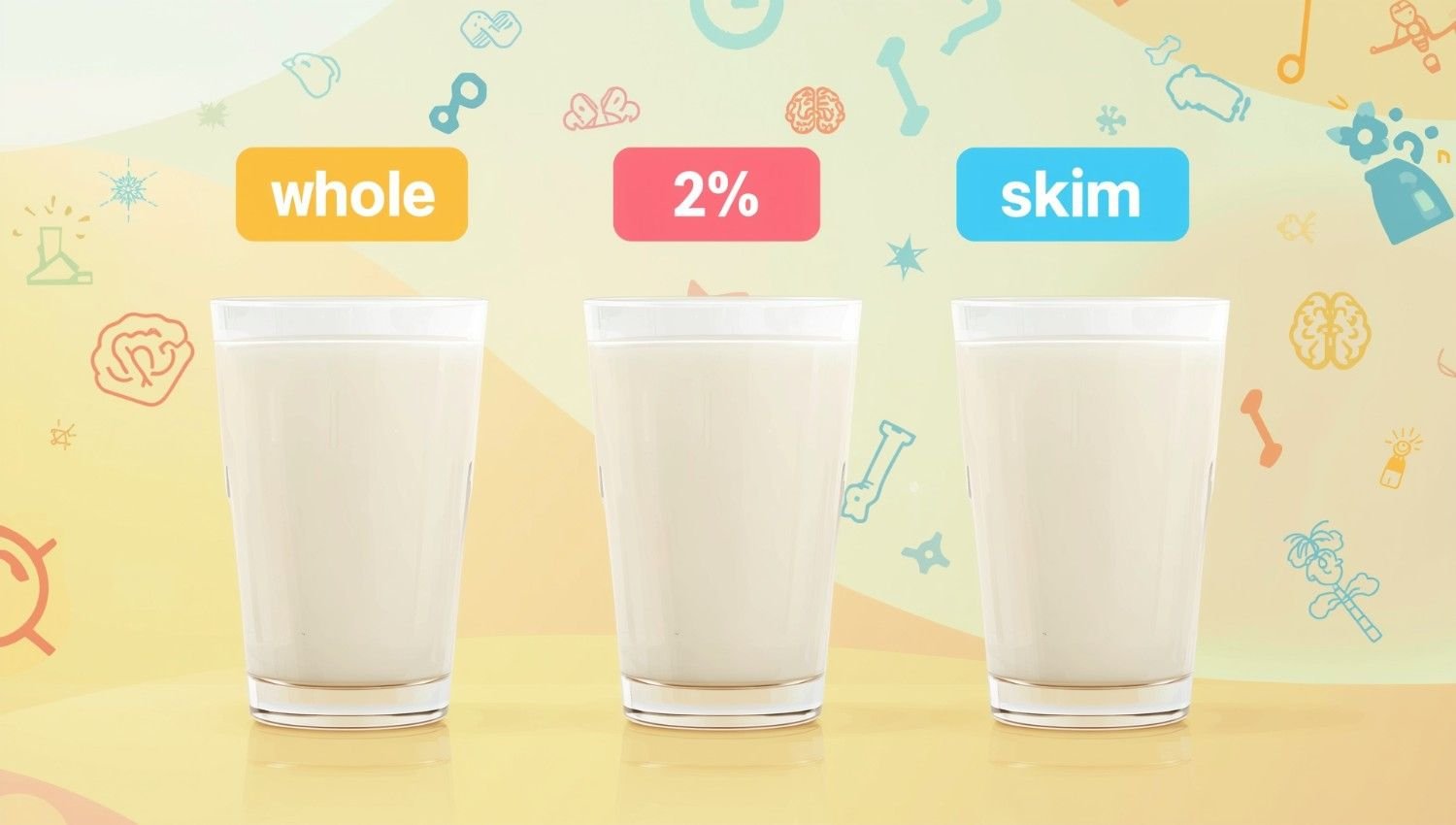Introduction
As a parent, deciding what kind of milk your child should drink can feel confusing. Should you choose whole milk, 2%, or something lighter like 1% or skim? Many experts—including Emily LaRose, DrPH, MS, RDN—have medically reviewed this topic and agree that cow’s milk remains one of the healthiest drinks for kids when chosen wisely. Whether you’re deciding what to serve at breakfast or after school, it helps to understand how each type fits into your child’s diet.
According to the American Academy of Pediatrics (AAP), whole milk is an excellent source of calcium, vitamin D, and protein for both children and adults. The AAP recommends that children drink whole milk until the age of 2, then switch to 1% or 2% milk depending on their age and growth needs. Most kids should drink two to three glasses of milk daily, roughly 16 to 24 ounces, especially if they aren’t eating or drinking calcium-rich foods like yogurt, cheese, or calcium-fortified orange juice. Still, concerns about childhood obesity may lead some parents to wonder whether to serve whole milk or a low-fat cow’s milk instead. Ultimately, what you give your kids—whether whole milk or low-fat cow’s milk—depends on their nutrition, growth patterns, and overall health.
Toddlers: Whole Milk vs. Skim Milk
During my daughter Kristen’s routine checkup, our pediatrician and I talked about her diet—specifically the fortified whole milk she had been drinking since she turned 1 year old. In my home country, Guatemala, most children are given powdered milk from well-known brands, often fortified with vitamins, probiotics, and plenty of fat. According to the label, one serving contained 5.9 grams of saturated fat and 20 grams of total fat. Since Kristen wasn’t a picky eater and already had a balanced diet, our doctor suggested switching her to skim milk, the same type my husband and I drink. To my surprise, she loved it and has been drinking it ever since.
Later, over dinner with friends who had older kids, we talked about how they also switched their children’s milk from whole to skimmed milk. Their nutritionist advised parents to make the switch by around 3 years of age to reduce obesity risk factors, heart disease, and cholesterol problems. The pediatrics academy recommends low-fat milk (no more than 2 percent fat) for 1-year-olds who are overweight or have a family history of heart problems. As babies become toddlers, their fat needs come from other sources—not just milk. Still, if your toddler’s nutrition or health is a concern, especially for picky eaters, whole milk can help provide extra calories and vitamins, minerals, and protein. A quick comparison of nutrition labels shows that whole milk, low-fat, and nonfat milk differ mainly in fat and calories, not in essential nutrients.
As a parent, I focus on healthy fats from foods like avocado, peanut butter, almond butter, olive oil, and salmon to balance my child’s diet. These fats are vital components for building tissues, the brain, and the central nervous system, especially in a growing toddler. Whether it’s 2%, 1%, or skim milk, I’ve found that making a gradual switch helps children adapt easily. Some older kids may resist switching to low-fat milk, but easing into it ensures they still get the nutrition they need without losing the taste they enjoy.
Is Whole 2% or a Lower-Fat Milk Best?
When my baby turned 1 year old, I remember wondering whether to continue breastfeeding, switch to iron-fortified infant formula, or start pasteurized whole cow’s milk. Many parents feel unsure about this transition. The American Academy of Pediatrics (AAP) says it’s safe to give cow’s milk at that stage, as long as your child doesn’t have allergies, sensitivities, or issues with cow’s milk protein or lactose. For those with sensitivity, lactose-free milk can be a good option. Once your child starts drinking milk daily—about 16 ounces a day—it should supplement breastfeeding or replace formula.
After a child’s first birthday, many parents wonder when to switch from whole milk to 2% or lower-fat milk. The AAP previously recommended low-fat milk after age 2, but updated guidelines now suggest making decisions based on excess weight, obesity, or family history of heart disease. A report from 2008 on lipid screening and cardiovascular health in childhood reshaped these recommendations. Today, whole milk remains recommended until a child turns 2, unless health risks suggest otherwise.

When to Give Children Whole Milk vs. 2%?
The AAP advises parents that reduced-fat milk may be appropriate for children aged 12 months to 2 years who have excess weight, obesity, or a family history of high cholesterol or cardiovascular disease. As a mom, I’ve seen how understanding these small details makes a big difference in choosing milk that supports my child’s growth and long-term health.
Choosing Whole Milk
For toddlers over 12 months, whole milk is often the best choice—especially for those no longer breastfeeding or drinking formula. The AAP explains that young children need calories from fat to support growth and brain development. These nutrients are particularly important during the first two years of a child’s life. A big benefit of whole milk over low-fat milk is its taste—most kids prefer it. Some may even refuse to drink anything else, making whole milk a practical choice for parents of picky eaters.
However, moderation matters. Too many calories or fat can become an obesity concern. Parents should include milk wisely in the child’s diet, balancing it with nutrient-rich foods. When in doubt, talk to a health care provider or a registered dietitian to meet nutritional needs safely.
Choosing Low-Fat Milk
While the AAP recognizes the benefits of whole milk for younger toddlers, it also encourages parents to switch children to skim or low-fat milk by age 2—especially if there’s a family tendency toward excess weight or obesity. From experience, transitioning early helps kids adapt to lighter milk without complaint, supporting healthy habits from the start.

Calories and Fat Content of Whole vs. Lower-Fat Milk
When I first compared calories and fat content between whole and lower-fat milk, I was surprised at how small the differences really were. A quick look at nutrition labels for an 8-ounce serving shows:
- Whole milk: 150 calories, 8 grams of fat
- 2% milk: 120 calories, 5 grams of fat
- 1% milk: 106 calories, 2 grams of fat
- Skim milk: 83 calories, 0 grams of fat
For most families, these nutritional differences are minor. The real question is whether your child’s diet needs those extra calories for growth and energy. A child who drinks 3 cups of milk a day could easily consume 132 more calories from whole milk compared to 1% milk. This is why knowing your child’s needs helps you find the right balance.
Tip
When making the switch to low-fat milk, start early—at a young age—so your child won’t notice or resist the change. I’ve found that a gentle transition works best: move gradually from whole milk to 2%, then 1%, and finally skim milk if desired. Establishing this routine helps children build healthy habits that last a lifetime. As a parent, watching my kids grow up drinking low-fat milk made me realize how simple choices today shape their preferences as teens and adults.
If your family enjoys variety, try soy milk, almond milk, or rice milk—all great dairy milk alternatives. These are typically low in fat but sometimes higher in sugar, so check the labels carefully. For children with allergies to cow’s milk or who are lactose intolerant, non-dairy milk options can be a healthy and balanced choice once they reach the 2-year mark. The goal is to find what works for your child’s diet while keeping nutrition and taste in harmony.
Conclusion
Choosing the right type of milk for your child—whole, 2%, or lower-fat milk—depends on their age, growth needs, and overall diet. For most toddlers, whole milk supports healthy growth, brain development, and provides essential fats that build strong tissues and nervous system connections. As your child grows, switching gradually to low-fat or skim milk can help balance calorie intake while still supplying vital nutrients like calcium, vitamin D, and protein.
The American Academy of Pediatrics (AAP) recommends whole milk until age 2, and low-fat milk afterward—especially if there’s a family history of obesity or heart disease. However, every child is unique. A pediatrician or registered dietitian can guide you on when to make the switch based on your child’s nutrition, activity level, and growth patterns. The goal is to create lifelong healthy habits—from choosing nutrient-rich milk to enjoying a well-rounded diet full of balance, flavor, and care.
FAQs About Milk Choices for Kids
1. When should my child switch from whole milk to low-fat milk?
Most children can transition from whole milk to low-fat milk after age 2. However, if your child has a family history of obesity, high cholesterol, or heart disease, your pediatrician may recommend switching earlier.
2. Is whole milk bad for toddlers?
No, whole milk is not bad for toddlers. It provides healthy fats essential for brain growth and development during the first two years of life.
3. Can low-fat or skim milk meet my child’s nutritional needs?
Yes. Both low-fat and skim milk contain the same vitamins, minerals, and protein as whole milk, just with less fat and fewer calories.
4. What if my child refuses low-fat milk?
Some kids prefer the taste of whole milk. You can make the switch gradually—start by mixing whole milk with 2%, then move to 1%, and finally to skim milk once they adjust to the taste.
5. How much milk should kids drink each day?
Typically, children need two to three cups (16–24 ounces) of milk daily. Too much milk can reduce their appetite for other nutrient-dense foods.
6. What are healthy fat alternatives if I switch to low-fat milk?
Add avocado, nut butters, olive oil, or salmon to your child’s diet to provide healthy fats that support growth and energy.
7. Is non-dairy milk like soy or almond milk a good substitute?
Yes, but check for calcium and vitamin D fortification. Soy milk is the closest nutritionally to cow’s milk, while almond or rice milk tend to be lower in protein and higher in sugar.
8. Does milk cause obesity in children?
There’s no strong evidence that whole milk alone causes obesity. What matters is overall diet, portion size, and activity levels.
9. Can babies under 1 year drink cow’s milk?
No. Babies under 12 months should drink breast milk or iron-fortified formula, not cow’s milk.
10. Should I consult a doctor before changing my child’s milk type?
Yes. Always talk to your pediatrician or registered dietitian before making major dietary changes. They can ensure your child’s nutritional needs and growth goals are being met.

